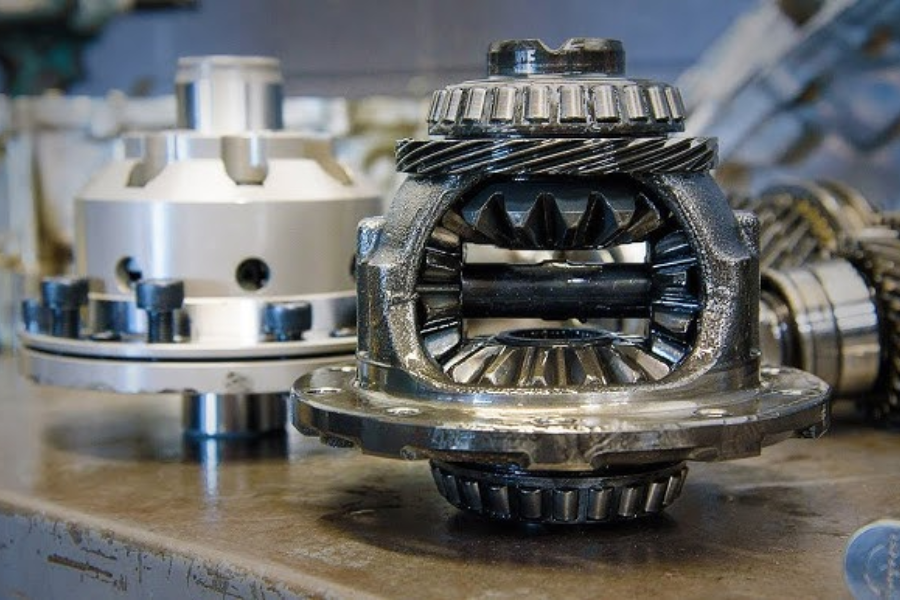The OS Giken R200 installation is a transformative upgrade for automotive enthusiasts seeking enhanced performance. This detailed guide will walk you through each step of the installation process, ensuring you can successfully improve your vehicle’s handling and traction with this high-quality differential.
What is the OS Giken R200 Differential?
The OS Giken R200 Differential is a limited-slip differential (LSD) that is engineered to enhance traction and handling in high-performance vehicles. Unlike open differentials that allow for significant differences in wheel rotation speed, the R200 limits this difference, providing better power distribution between the drive wheels. This feature is particularly advantageous in high-stress driving scenarios, such as racing or aggressive cornering.
OS Giken, a reputable Japanese manufacturer, has established a strong reputation for producing performance car parts. Their R200 differential has garnered popularity among both street performance drivers and racing enthusiasts, known for its robustness and ability to handle high torque loads without compromising reliability.
Tools and Materials You’ll Need
Before diving into the installation, gather the necessary tools and materials to ensure a smooth process:
Tools:
- Socket set
- Torque wrench
- Hydraulic jack
- Jack stands
- Fluid pump
Materials:
- New gear oil (specific to the OS Giken R200)
- Replacement gaskets and seals
- Safety equipment (gloves and safety glasses)
- Vehicle repair manual (specific to your model)
Having all these items ready will save time and reduce frustration during the installation.
Step-by-Step Installation Process
Installing the OS Giken R200 requires precision and attention to detail. Follow this step-by-step guide for a successful upgrade to your vehicle’s differential.
Step 1: Prepare the Vehicle
Start by ensuring your car is parked on a flat surface. Engage the parking brake and chock the front wheels to prevent any movement. Using a hydraulic jack, lift the rear of the vehicle, then place jack stands under the recommended lifting points. Carefully lower the car onto the jack stands, ensuring it is stable before you proceed with the installation.
Step 2: Remove the Driveshaft
Next, locate the driveshaft connection at the differential. For easier reassembly later, mark the position of the driveshaft. Remove the bolts that secure the driveshaft to the differential flange, then carefully lower the driveshaft and set it aside. Handle it gently to avoid damaging the seals or the driveshaft itself. Be sure to keep track of all hardware removed during this step.
Step 3: Drain the Old Gear Oil
Locate the drain plug on the differential housing and place a drain pan underneath to catch the old oil. Remove the drain plug and allow all the oil to drain completely. This step is crucial, as clean oil is essential for the new differential’s longevity and performance. Dispose of the old oil responsibly, as it can be messy.
Step 4: Remove the Old Differential
Disconnect any brake lines or ABS sensors that may be attached to the differential. Remove the bolts securing the differential to the axle housing; you might also need to detach the axle shafts, depending on your vehicle model. Carefully extract the old differential from the housing, noting that it can be quite heavy. Remember to keep any shims or spacers for the installation of the new differential.
Step 5: Install the OS Giken R200 Differential
Position the new OS Giken R200 differential into the housing, ensuring that it is seated properly and aligned with the mounting points. Replace any shims or spacers in their original locations. Secure the new differential by tightening the mounting bolts with a torque wrench according to the manufacturer’s specifications. Double-check all connections to ensure everything is in place before moving on.
Step 6: Reinstall the Driveshaft and Axles
If you removed the axle shafts earlier, reattach them now. Ensure they are fully seated. Lift the driveshaft back into position, aligning it with your earlier markings. Securely bolt the driveshaft back to the differential flange, using the appropriate torque specifications. Make sure everything rotates smoothly without any binding or strange noises.
Step 7: Fill with Gear Oil
Locate the fill plug on the new OS Giken R200 differential. Use a fluid pump to add the correct type and amount of gear oil as specified for the R200. Fill the differential until oil begins to seep from the fill hole, then replace and torque the fill plug to spec. Wipe away any spills to maintain cleanliness around the installation area.
Step 8: Test the Installation
Once everything is reassembled, carefully lower the vehicle back to the ground. Start the engine and let it idle for a few minutes. Listen for any unusual sounds that could indicate a problem with your installation. After a brief warm-up, take the car for a short test drive to evaluate how it handles and accelerates. Pay attention to any differences in performance. If all feels well, congratulations—you have successfully installed the OS Giken R200!
Benefits of the OS Giken R200 Differential
Upgrading to the OS Giken R200 differential brings several significant advantages over stock differentials, making it a preferred choice for performance enthusiasts.
1. Improved Traction
The OS Giken R200 drastically improves your vehicle’s traction capabilities. It effectively distributes power more evenly across the wheels, which becomes especially noticeable during acceleration and cornering. Drivers will appreciate reduced wheel spin and enhanced control, making this differential an asset in both dry and wet driving conditions.
2. Enhanced Durability
Designed to endure high-stress situations, the OS Giken R200 is constructed from high-quality materials with meticulous engineering. It can handle more power than many factory differentials, making it ideal for racing applications and heavily modified street cars. This durability gives drivers the confidence to push their vehicles to the limit.
3. Smoother Power Delivery
After installing the OS Giken R200, you will experience a noticeable improvement in power delivery. The differential’s superior management of power distribution translates into more predictable and controlled acceleration. Drivers will find the vehicle feels more responsive and balanced, especially during rapid acceleration or when exiting corners.
4. Customizable Setup
One of the standout features of the OS Giken R200 is its adjustability. Drivers can fine-tune the differential’s characteristics to better match their driving style. This level of customization allows for optimal performance under various conditions, with many models enabling adjustments to preload and ramp angles. Such features are generally not available with standard differentials, which makes the R200 highly appealing to performance enthusiasts.
Conclusion
The installation of the OS Giken R200 differential is a worthwhile upgrade for any performance-focused driver. With significant enhancements in traction, durability, and customization, the benefits are clear. While the installation process requires careful attention and patience, the results are rewarding.
After installation, be sure to follow the manufacturer’s break-in procedures to ensure optimal performance. With proper installation and maintenance, your OS Giken R200 will deliver years of enhanced driving experiences and improved performance on the road or track. Enjoy the journey as you transform your vehicle into a more powerful and responsive machine!
Facts
- Product: OS Giken R200 Differential
- Type: Limited-slip differential (LSD)
- Purpose: Enhances traction and handling in high-performance vehicles.
- Manufacturer: OS Giken, a reputable Japanese performance parts manufacturer.
- Key Benefits:
- Improved traction during acceleration and cornering.
- Enhanced durability for high-stress driving conditions.
- Smoother power delivery and better vehicle responsiveness.
- Customizable setup for fine-tuning performance characteristics.
- Tools Required: Socket set, torque wrench, hydraulic jack, jack stands, fluid pump.
- Materials Needed: New gear oil, replacement gaskets and seals, safety equipment, vehicle repair manual.
- Installation Steps: Prepare the vehicle, remove the driveshaft, drain old oil, remove the old differential, install the new differential, reinstall driveshaft and axles, fill with gear oil, and test the installation.
FAQs
Q1: What is the OS Giken R200 differential?
A1: The OS Giken R200 is a limited-slip differential designed to improve traction and handling in high-performance vehicles by limiting the difference in wheel rotation speed.
Q2: What are the benefits of installing an OS Giken R200 differential?
A2: Benefits include improved traction, enhanced durability, smoother power delivery, and customizable settings to match driving styles.
Q3: What tools do I need for the installation?
A3: You will need a socket set, torque wrench, hydraulic jack, jack stands, and a fluid pump.
Q4: How do I properly install the OS Giken R200?
A4: The installation process involves preparing the vehicle, removing the driveshaft, draining old oil, removing the old differential, installing the new differential, reinstalling the driveshaft, filling it with gear oil, and testing the installation.
Q5: Is the installation of the OS Giken R200 difficult?
A5: While the installation requires careful attention and some mechanical knowledge, following the step-by-step guide can help ensure success. It’s recommended to consult a vehicle repair manual specific to your model.
Q6: How should I maintain the OS Giken R200 after installation?
A6: Regularly check the differential oil level and condition, follow the manufacturer’s break-in procedures, and ensure all components remain tight and secure.
Q7: Can the OS Giken R200 differential be customized?
A7: Yes, it features adjustable settings for preload and ramp angles, allowing drivers to fine-tune its performance characteristics to suit their driving style.
The OS Giken R200 installation is a transformative upgrade for automotive enthusiasts seeking enhanced performance. This detailed guide will walk you through each step of the installation process, ensuring you can successfully improve your vehicle’s handling and traction with this high-quality differential.
What is the OS Giken R200 Differential?
The OS Giken R200 Differential is a limited-slip differential (LSD) that is engineered to enhance traction and handling in high-performance vehicles. Unlike open differentials that allow for significant differences in wheel rotation speed, the R200 limits this difference, providing better power distribution between the drive wheels. This feature is particularly advantageous in high-stress driving scenarios, such as racing or aggressive cornering.
OS Giken, a reputable Japanese manufacturer, has established a strong reputation for producing performance car parts. Their R200 differential has garnered popularity among both street performance drivers and racing enthusiasts, known for its robustness and ability to handle high torque loads without compromising reliability.
Tools and Materials You’ll Need
Before diving into the installation, gather the necessary tools and materials to ensure a smooth process:
Tools:
- Socket set
- Torque wrench
- Hydraulic jack
- Jack stands
- Fluid pump
Materials:
- New gear oil (specific to the OS Giken R200)
- Replacement gaskets and seals
- Safety equipment (gloves and safety glasses)
- Vehicle repair manual (specific to your model)
Having all these items ready will save time and reduce frustration during the installation.
Step-by-Step Installation Process
Installing the OS Giken R200 requires precision and attention to detail. Follow this step-by-step guide for a successful upgrade to your vehicle’s differential.
Step 1: Prepare the Vehicle
Start by ensuring your car is parked on a flat surface. Engage the parking brake and chock the front wheels to prevent any movement. Using a hydraulic jack, lift the rear of the vehicle, then place jack stands under the recommended lifting points. Carefully lower the car onto the jack stands, ensuring it is stable before you proceed with the installation.
Step 2: Remove the Driveshaft
Next, locate the driveshaft connection at the differential. For easier reassembly later, mark the position of the driveshaft. Remove the bolts that secure the driveshaft to the differential flange, then carefully lower the driveshaft and set it aside. Handle it gently to avoid damaging the seals or the driveshaft itself. Be sure to keep track of all hardware removed during this step.
Step 3: Drain the Old Gear Oil
Locate the drain plug on the differential housing and place a drain pan underneath to catch the old oil. Remove the drain plug and allow all the oil to drain completely. This step is crucial, as clean oil is essential for the new differential’s longevity and performance. Dispose of the old oil responsibly, as it can be messy.
Step 4: Remove the Old Differential
Disconnect any brake lines or ABS sensors that may be attached to the differential. Remove the bolts securing the differential to the axle housing; you might also need to detach the axle shafts, depending on your vehicle model. Carefully extract the old differential from the housing, noting that it can be quite heavy. Remember to keep any shims or spacers for the installation of the new differential.
Step 5: Install the OS Giken R200 Differential
Position the new OS Giken R200 differential into the housing, ensuring that it is seated properly and aligned with the mounting points. Replace any shims or spacers in their original locations. Secure the new differential by tightening the mounting bolts with a torque wrench according to the manufacturer’s specifications. Double-check all connections to ensure everything is in place before moving on.
Step 6: Reinstall the Driveshaft and Axles
If you removed the axle shafts earlier, reattach them now. Ensure they are fully seated. Lift the driveshaft back into position, aligning it with your earlier markings. Securely bolt the driveshaft back to the differential flange, using the appropriate torque specifications. Make sure everything rotates smoothly without any binding or strange noises.
Step 7: Fill with Gear Oil
Locate the fill plug on the new OS Giken R200 differential. Use a fluid pump to add the correct type and amount of gear oil as specified for the R200. Fill the differential until oil begins to seep from the fill hole, then replace and torque the fill plug to spec. Wipe away any spills to maintain cleanliness around the installation area.
Step 8: Test the Installation
Once everything is reassembled, carefully lower the vehicle back to the ground. Start the engine and let it idle for a few minutes. Listen for any unusual sounds that could indicate a problem with your installation. After a brief warm-up, take the car for a short test drive to evaluate how it handles and accelerates. Pay attention to any differences in performance. If all feels well, congratulations—you have successfully installed the OS Giken R200!
Benefits of the OS Giken R200 Differential
Upgrading to the OS Giken R200 differential brings several significant advantages over stock differentials, making it a preferred choice for performance enthusiasts.
1. Improved Traction
The OS Giken R200 drastically improves your vehicle’s traction capabilities. It effectively distributes power more evenly across the wheels, which becomes especially noticeable during acceleration and cornering. Drivers will appreciate reduced wheel spin and enhanced control, making this differential an asset in both dry and wet driving conditions.
2. Enhanced Durability
Designed to endure high-stress situations, the OS Giken R200 is constructed from high-quality materials with meticulous engineering. It can handle more power than many factory differentials, making it ideal for racing applications and heavily modified street cars. This durability gives drivers the confidence to push their vehicles to the limit.
3. Smoother Power Delivery
After installing the OS Giken R200, you will experience a noticeable improvement in power delivery. The differential’s superior management of power distribution translates into more predictable and controlled acceleration. Drivers will find the vehicle feels more responsive and balanced, especially during rapid acceleration or when exiting corners.
4. Customizable Setup
One of the standout features of the OS Giken R200 is its adjustability. Drivers can fine-tune the differential’s characteristics to better match their driving style. This level of customization allows for optimal performance under various conditions, with many models enabling adjustments to preload and ramp angles. Such features are generally not available with standard differentials, which makes the R200 highly appealing to performance enthusiasts.
Conclusion
The installation of the OS Giken R200 differential is a worthwhile upgrade for any performance-focused driver. With significant enhancements in traction, durability, and customization, the benefits are clear. While the installation process requires careful attention and patience, the results are rewarding.
After installation, be sure to follow the manufacturer’s break-in procedures to ensure optimal performance. With proper installation and maintenance, your OS Giken R200 will deliver years of enhanced driving experiences and improved performance on the road or track. Enjoy the journey as you transform your vehicle into a more powerful and responsive machine!
Facts
- Product: OS Giken R200 Differential
- Type: Limited-slip differential (LSD)
- Purpose: Enhances traction and handling in high-performance vehicles.
- Manufacturer: OS Giken, a reputable Japanese performance parts manufacturer.
- Key Benefits:
- Improved traction during acceleration and cornering.
- Enhanced durability for high-stress driving conditions.
- Smoother power delivery and better vehicle responsiveness.
- Customizable setup for fine-tuning performance characteristics.
- Tools Required: Socket set, torque wrench, hydraulic jack, jack stands, fluid pump.
- Materials Needed: New gear oil, replacement gaskets and seals, safety equipment, vehicle repair manual.
- Installation Steps: Prepare the vehicle, remove the driveshaft, drain old oil, remove the old differential, install the new differential, reinstall driveshaft and axles, fill with gear oil, and test the installation.
FAQs
Q1: What is the OS Giken R200 differential?
A1: The OS Giken R200 is a limited-slip differential designed to improve traction and handling in high-performance vehicles by limiting the difference in wheel rotation speed.
Q2: What are the benefits of installing an OS Giken R200 differential?
A2: Benefits include improved traction, enhanced durability, smoother power delivery, and customizable settings to match driving styles.
Q3: What tools do I need for the installation?
A3: You will need a socket set, torque wrench, hydraulic jack, jack stands, and a fluid pump.
Q4: How do I properly install the OS Giken R200?
A4: The installation process involves preparing the vehicle, removing the driveshaft, draining old oil, removing the old differential, installing the new differential, reinstalling the driveshaft, filling it with gear oil, and testing the installation.
Q5: Is the installation of the OS Giken R200 difficult?
A5: While the installation requires careful attention and some mechanical knowledge, following the step-by-step guide can help ensure success. It’s recommended to consult a vehicle repair manual specific to your model.
Q6: How should I maintain the OS Giken R200 after installation?
A6: Regularly check the differential oil level and condition, follow the manufacturer’s break-in procedures, and ensure all components remain tight and secure.
Q7: Can the OS Giken R200 differential be customized?
A7: Yes, it features adjustable settings for preload and ramp angles, allowing drivers to fine-tune its performance characteristics to suit their driving style.








